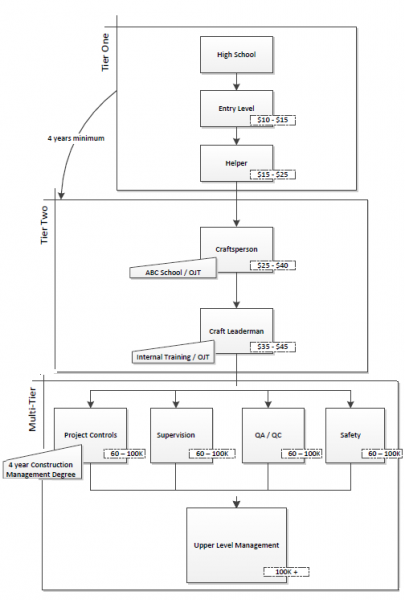Strategies for mapping out a career path in construction
Construction companies are finding it ever harder to compete for skilled craft workers based on salaries alone. Providing long-time career mobility could help them attract and retain the best talent.

With wages for in-demand skilled craft professionals rising at comparable levels across the U.S. petrochemical and construction sectors, a growing number owners and service contractors are investing more in overall career path development to attract the best workers and maintain competitive advantage.
Average annual salaries – not including overtime, per diem and other incentives – for skilled craft workers such as ironworkers, mobile crane operators, millwright and electronic systems technicians in the United States ranged between about $51,500 and $66,500, according to the 2014 craft professional survey released on February 2 by the National Center for Construction Education and Research (NCCER). Project supervisors and project managers topped the list, earning more than $79,000 and $91,000, respectively. Of the 17 total craft professions included in the study, 15 experienced wage increases on the back of growing demand for these trades across the industry.
Yet, industry experts agree that companies are finding it ever harder to compete for skilled workers based on salaries alone. More and more in-demand welders, pipefitters and crane operators are also choosing their employers based on companies' safety record, supervision capacity, work environment, on-boarding program, ease of recruitment, on-site facilities and local communities, among many other factors.
As they find themselves in high demand both in the upstream and downstream energy industries, skilled craft professionals, in particular, want to own their careers. This means that it is becoming more important for contractors to create internal opportunities for their workforce by developing comprehensive career pathways that show clear upward and lateral mobility in the long-term.
Options for Promotion
To develop talent, some businesses in the sector are embedding career paths that set out the options for promotion and the training and experience that each employee should have at each step of their development. This is especially important as reaching to a full journeyman level requires at least four years on the job and thus a heavy investment both on the part of the company and the worker. Flexible career paths are also far more appealing to employees than a one-size-fits-all template.
“Employees want to see that companies are investing in them, that they are helping them develop and grow in their careers by providing them with things like craft progression programs – where they are rewarded for the skills that they attain,” NCCER President Don Whyte said. “It’s the total employment package. That makes a very loyal employee and a very happy employee.”
Build Your Future (BYF), a NCCER initiative providing a collaborative grassroots approach to construction workforce forecasting and development – including recruitment, training, placement, retention and image enhancement strategies – features an online interactive career path for the industry. The career track maps out in detail the options for construction professionals from middle school to the C-suite.
High school and technical school graduates can typically get their foot in the door as industry apprentices or find entry-level positions after attending community college. After craft professionals develop experience as journeymen, they can typically move up to become project superintendents or project managers, as well as estimators, planners and schedulers on projects. Others have progressed as support as a safety or human resources professionals, or to procurement and warehousing. University graduates can start directly as assistant project managers before advancing to more senior managerial roles.
Turner Industries is one of the companies that has replicated the BYF model to create has an individual career path for industrial maintenance and construction workers that shows a clear progression track, according to Raymond Neck Jr., one of the company’s training managers. An entry-level worker who earns $10-15 per hour today can earn as much as $25-40 as a craftsperson after about four years, pending completion of the right training and on-the-job experience. Craftspeople can progress to craft leadermen and further to managerial roles – where annual salaries typically range between $60,000 and $100,000 – or executive positions.

Turner Industries' Industrial Maintenance and Construction Career Path. Source: Turner Industries
“Whether you are a welder or pipefitter, your opportunities in the sector are endless,” said Steve Greene, vice president of NCCER, which has since the early 1990s provided training, curricula, assessments and standards for both workers and training instructors. “It’s not about a job on a project, it’s about a career in an industry.”
